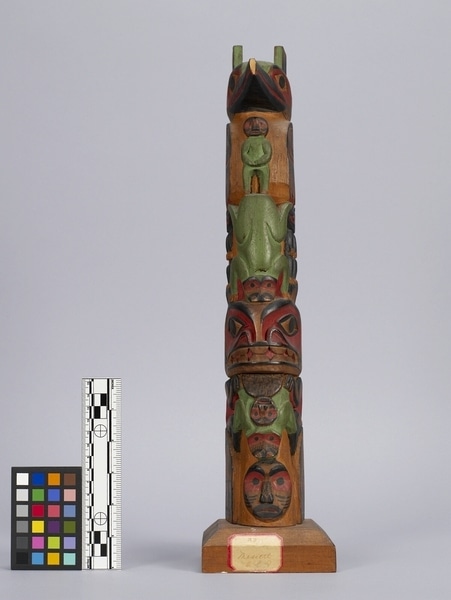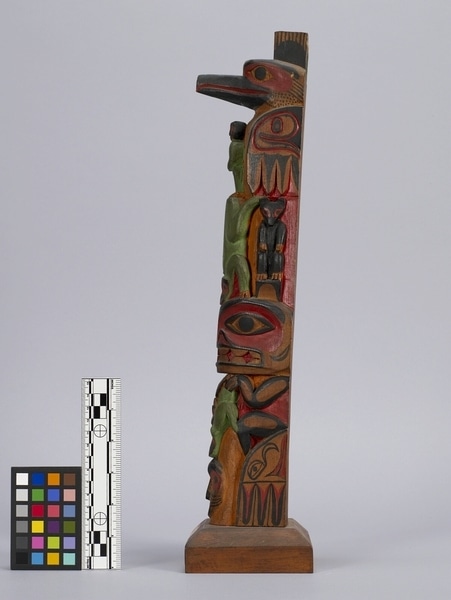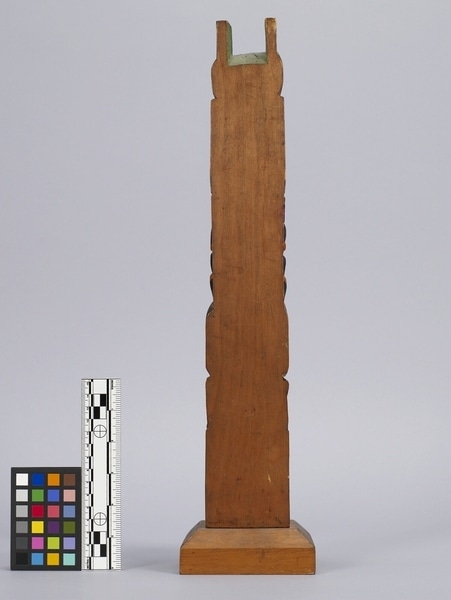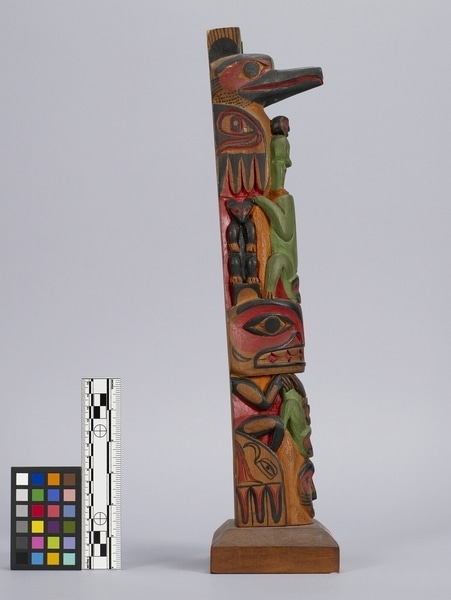Model Totem Pole Item Number: A8766 from the MOA: University of British Columbia




Description
A model totem pole depicting an animal with wing-like features below holding an upside down human as well as a frog and face, and a bird with a human and a frog in front of it (from bottom to top). The animal at the bottom has circular black eyes surrounded by a tapering black oval and a red area with black brows above, nostrils, black u form ears, an open black lined red mouth showing fourteen plain teeth, black limbs, and three-feathered red and black u form side wings that have a black eye and beak form and a red split u along the upper part. The upside down human has circular black eyes surrounded by a red circle with black brows above, a triangular nose with black nostrils, a red mouth, and a black dashed body. The frog is facing downward with circular black eyes surrounded by a red area with a black dashed nose with black nostrils and a green body. The face has circular black eyes surrounded by a red area with black brows above, a black dashed nose with black nostrils, a black lined red mouth, and four horizontal black lines across each cheek. The bird at the top has circular black eyes surrounded by a plain tapering oval and a red area with black brows above and a green forehead, a red lined black beak, black u form and vertically lined ears. A black dotted neck, and four-feathered black u form side wings that has a red and black eye form along the upper part. The human in front has similar facial features to the one below it but has a green body and is standing with his hands in front. The frog below in front has similar features but with a plain nose. A standing black bear is at either side of this frog. Nails attach it to a square base.
Narrative
This pole is very similar to another model pole that was indicated to have been carved by an artist named Sam Jackson, in Port Renfrew, BC, ca. 1940 (likely a Pacheedaht carver). However, based on the interlacing of smaller figures and some of the sculptural features on this pole, it appears to be an interpretation of a more northern style of pole, perhaps Tsimshian or Nisga'a? (Christopher Smith, 2021)
Item History
- Made in British Columbia, Canada during 1930
- Collected between 1893 and 1934
- Owned by George H. Raley before November 1948
- Received from H. R. MacMillan (Funding source) and George H. Raley (Seller) during November 1948
What
- Name
- Model Totem Pole
- Identification Number
- A8766
- Type of Item
- totem pole
- Material
- wood, paint and metal
- Overall
- height 43.1 cm, width 10.7 cm, depth 10.5 cm
Who
- Culture
- Nuu-chah-nulth ?
- Previous Owner
- George H. Raley
- Received from
- H. R. MacMillan (Funding source) and George H. Raley (Seller)
Where
- Holding Institution
- MOA: University of British Columbia
- Made in
- British Columbia, Canada
When
- Creation Date
- during 1930
- Collection Date
- between 1893 and 1934
- Ownership Date
- before November 1948
- Acquisition Date
- during November 1948
Other
- Condition
- fair
- Accession Number
- 1960/0560